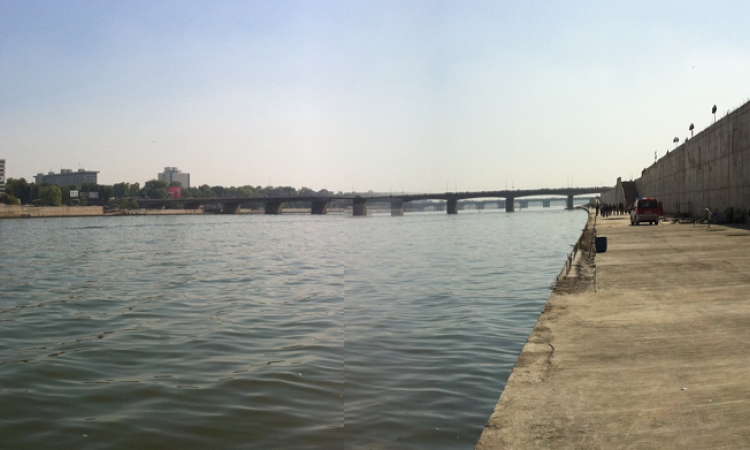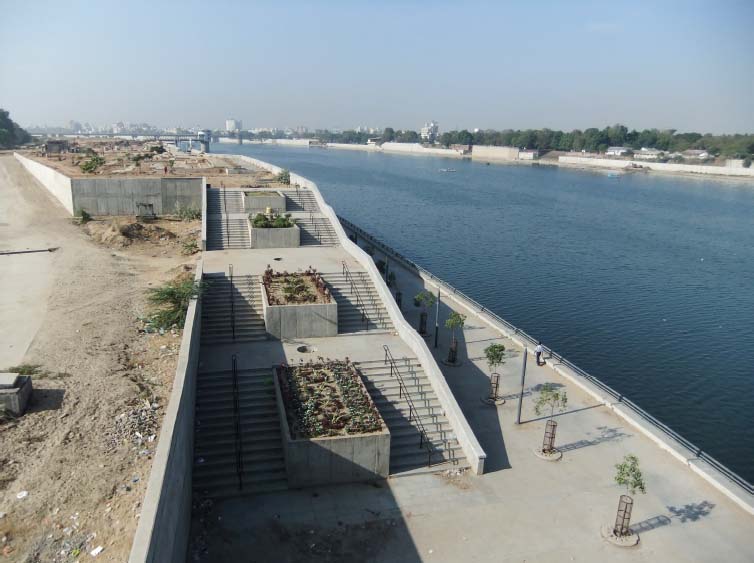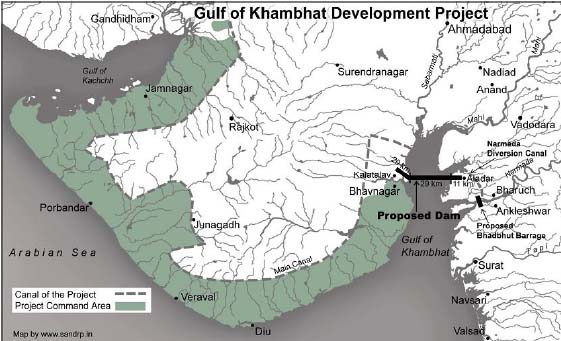
Introduction
The series coordinated by Prof. Ramaswamy R Iyer aimed at understanding what has been happening to rivers across India and in drawing appropriate lessons. The lecture,on February 29, 2012 at the India International Centre, New Delhi began with an account of the variations in water availability in Gujarat and the typical problem of excessive groundwater use leading to increasing salinity ingression in its coastal areas. The poor management of existing large dams in the state was discussed through the analysis of the dam operation and rainfall pattern in the catchment of the Ukai reservoir. Just how the man-made mishap of 2006 could have been avoided was talked about.
The case of the Sardar Sarovar Project, built at huge social, financial & environmental costs and how its waters are being used for the Sabarmati riverfront project was dealt with. The lecture concluded with an account of the cases of river revival and sustainable water management in the state.
Talk by Himanshu Thakkar on 'Rivers of Gujarat'
What is a healthy, living river?
Himanshu Thakkar began the lecture with an account of what a healthy living river is like. He noted that there are no scientific papers that actually define a river. As per SANDRP “river is a hydrological, geomorphic, ecological, biodiversity rich, landscape level system that serves as key part of freshwater cycle, balancing dynamic, though not always continuum (e.g. discontinuity when tributaries meet a river) equilibrium between soil moisture, snowfall, rainfall, surface water and groundwater and providing large number of social, environmental, economic, cultural, aesthetic, religious services to the people and ecosystems all along its watershed.”
Many variations, many contradictions
Thakkar gave a detailed account of the rainfall variation and the water availability in the rivers of Gujarat. The rainfall in Gujarat varies from less than 400 mm in Kutch to above 1100 mm in South Gujarat.
Most of the rivers of Saurashtra and Kutch dry up in the summer, he stated. The river basins of Kutch are very small. This available water resource is marked with inequitable distribution - 71.4 per cent in South Gujarat, 10.6 per cent in North Gujarat, 15.8 per cent in Saurashtra and 2.2 per cent in Kutch.
Large dams in Gujarat
As per the Central Water Commission’s register of large dams (2009), Gujarat has 665 large dams, including 68 under construction. 122 dams are more than 50 years old. Gujarat is the third largest dam builder state of India after Maharashtra and Madhya Pradesh. One of the worst large dam disasters in India happened in Gujarat when the Macchu dam burst.
Groundwater: Increasing use, falling levels
About 90 per cent of irrigation in Gujarat depends on groundwater. The tube wells and open wells in north Gujarat pump out about 3,000 mcm groundwater annually against an annual replenishment of 2,400 mcm, leaving an annual deficit of about 600 mcm. The direct cost of groundwater depletion to the economy is to the tune of Rs 300 crore per year, as per an estimate.
This steep decline has occurred during a relatively wet period. In the next decadal period of low rainfall this rate could more than double, especially if farmers increase the cropping intensity. In spite of the electricity subsidy and the increase in energy use during the last two decades the corresponding increase in irrigated area has been inadequate. In other words, the “drop per unit of energy consumed” continues to deteriorate.
Systematic studies have not yet been made of the impact of the groundwater recharge movement in Gujarat, the popular science of rainwater harvesting, and decentralized recharge that have emerged as a result of farmers’ experiments. However, indicative evidence suggests that in regions critically afflicted by groundwater depletion, only popular mass action on a regional scale appears to be a satisfactory solution.
Salinity ingress in coastal areas
Excessive groundwater use has led to increasing salinity ingress in coastal areas. A recent report of Columbia Water Centre pointed out that water tables in the study area have been falling steadily over the last 15-20 years, and have reached about 600 ft below ground level, risking irreversible salinization of aquifers.
This is especially serious in Saurashtra and also in Mahi, Sabarmati and Narmada estuaries. As per CAG report of 2011 there has been an increase of 15 per cent in salinity ingress area, involving an additional affected area of 88,947 ha since 1977-1984.
While there is an immense evidence that salinity ingression, loss of estuarine biodiversity, fish and mangroves had been happening due to no freshwater flows from the upstream reservoirs, the Gujarat Water Resource Department refuses to believe these facts and states that the major reasons are less rainfall, weak land management and excessive groundwater lifting by farmers.
Along with salinity ingress, coastal erosion is found in 449 villages, which accelerates just before monsoon. Many studies have established the links between upstream dams which trap sediments and water and their direct impact on coastal erosion.
Management of existing large dams in Gujarat: The Ukai experience
The Surat flood of August 2006 after release of water from Ukai dam on the Tapi river in the upstream had caused a major human tragedy and property damage. Thakkar discussed how the analysis of the dam operation and rainfall pattern in the catchment of the Ukai reservoir indicates that this was a completely avoidable, man-made mishap.
As per Ukai reservoir design, it is supposed to have a flood cushion of 1.332 bcm. Since the carrying capacity of the river has decreased over the years, 3 lakh cusecs had to be released before Aug 1, 2006 but this was not done. The underlying issues that caused the Ukai mishap are still not being addressed. Similar conditions led to floods in Orissa from Hirakud in 2008 and 2011.
One reason why the dam authorities tend to keep high storages at dams like Ukai is for maximization of power generation. But the figures SANDRP found from the Central Electricity Authority were equally shocking. Even as the Ukai had unprecedented water storage and Gujarat was facing power deficit of up to 1500 MW, Ukai was not being used to generate power. And this situation continued right up to end of July 2006, when the power generation at Ukai was the lowest in 2006 till that point of time.
Sabarmati Riverfront Development

Thakkar also discussed the case of revivification of the riverfront by the Sabarmati Riverfront Development Corp (SRFDCL) set up in May 1997 by the Ahmedabad Municipal Corporation (AMC). In 2003, it extended the project to cover a 20-km stretch-from the Narmada main canal to Vasna barrage. As of now, SRFDCL is developing 190 ha of riverfront. Constant change in the plans has escalated the project cost from Rs 361 crore in 1997 to an estimated Rs 1,100 crore today. It is unknown as to how SRFDCL plans to service its debts.
According to the high court orders, at least 11,000 affected families were to be rehabilitated and resettled by AMC. That has not happened, but a demolition drive has been going on; over 3,000 people have moved to the outskirts of city.
A community organization and several NGOs argued that 30,000-40,000 households will be affected by the project, and they filed a case in the Gujarat High Court in 2005. The claims of the hutment dwellers that have been affected have not been examined properly. The civic body did not submit a resettlement policy to the court until 2008.
Narmada waters for Sabarmati riverfront?
Thakkar noted that the Sardar Sarovar Project, built at huge social, financial & environmental costs, which are still being paid by the lakhs of affected was not built for the riverfront project to have flowing water. The project was touted for Saurashtra, North Gujarat and Kutch, most of where water is yet to reach.
The riverfront ‘beautification’ project conveniently ignores the fact that the Sabarmati river is not just 10.6 km long and does not end at Vasna Barrage of Ahmedabad but flows beyond this through various villages, where people are facing severe problems because of contamination of the river.
It is also important to note what made Sabarmati seasonal in the first place. No water is released from the dams like Dharoi and Hatmati in the upstream. Changing ecology of one river through destruction of an entire system of another great river is convolution of restoration. Sabarmati riverfront, as it stands now aims to profit only the real estate developers in Ahmedabad. Incidentally, the water quality in the beautified ‘riverfront’ is still very bad.
How much unaccounted water can the Narmada provide?
Thakkar discussed the Gujarat Water Resources Department’s plan of using the Narmada flood waters through the projects undertaken or planned and then dealt with the saga of the river. In many senses, what defines Gujarat of today is mirrored in the history of the Narmada project and the struggle against it.
There are issues related to massive displacement, environment destruction, under estimated costs & impacts and lack of willingness to take care of the displaced or the environment impacts. Further, there was no attempt at options assessment when Narmada Bachao Andolan and others showed real options existed. Also there was massive deception that the project was for Kutch, Saurashtra and North Gujarat.
The project was marked with human rights violations, arrests, use of the might of the state to repress the movement, but they did not succeed. The movement achieved a lot and the dam remains incomplete today, though many have written off the movement as lost.
Gujarat’s future projects

Thakkar discussed the Kalpasar project, which proposes a 30 km long dam across the Gulf of Khambhat between Bharuch and Bhavnagar districts. This reservoir with 2000 sq km area, over five times the area of Sardar Sarovar will store about 10 BCM of surface water and will be the world’s largest fresh water reservoir in sea.
The water from the reservoir whose level is expected to move between 5 m above mean sea level and 5 m below mean sea level and is supposed to be pumped over the height of 65 m to feed a 15000 cusec canal that is going to be 660 km long, the longest canal of India. Its claimed benefits include drinking water supply of 1400 MCM, providing irrigation to 10 lakh ha, reclamation of 2 lakh ha of saline land, filling up more than 60 existing dams, generation of tidal power, reducing road distance between South Gujarat and Saurashtra, tourism, among others.
Nothing of this dimension has ever been undertaken in India, or possibly in the world. The Kalpasar ToR has been rejected by MoEF’s EAC and questions raised about viability of the project. It raised questions about feasibility, including the lack of a pre feasibility study. Even without going into the unprecedented impacts of the move on biodiversity and saline-freshwater balance of the Gulf of Khambat, there are some basic feasibility issues about the project.
As regards hydrological feasibility, all the rivers that flow into the proposed reservoir area are already dammed and water is over committed from those rivers. Also, whatever little water flows from these rivers into the Gulf is highly toxic.
Serious questions exist about the geological feasibility of constructing this earth and rock-filled, longest dam in the middle of the surging sea. The foundation is yet to be gauged. Also, there is the issue of salinity that exists in the gulf water and the soil underneath. The reservoir with shallow depth and huge area will have huge evaporation losses, and pumping all the water into the canals through a height of over 65 m would be hugely energy intensive.
Damanganga Pinjal link
This link proposes to transfer surpluses available between Par and Tapi to the tune of 1,350 mcm to water deficit areas in North Gujarat through a 401 km canal. The seven proposed reservoirs in this link would submerge 7,559 ha of which 3,572 ha is forest. 14,832 people and 9,029 livestock would be affected by the submergence. While dealing with this particular link Thakkar raised some basic questions about interlinking of rivers (ILR).
Severity of river pollution in Gujarat
Thakkar also discussed the severe river pollution in Gujarat and absolute ineffectiveness of the Gujarat Pollution Control Board. According to CPCB (2009 and 2010), three of the five most polluted river stretches in the country are in Gujarat. A recent police complaint against the GIDC and GPCB has highlighted the corruption and ineffectiveness in these agencies to check water pollution in Ankaleshwar.
Cases of river revival and sustainable water management from Gujarat
India’s biggest and most unique people driven movements for well recharging and check dam construction are from Gujarat. There are many other cases of exemplary work by community organizations and NGOs like AKRSP, DSC, Kutch Mahila Sangathan, Sambhaav, Utthan, Sadguru Foundation, Swadhyay Pariwar, Swaminarayan etc., that have contributed towards exemplary local water related work, including groundwater recharging, rainwater harvesting and check dam development.
In Gujarat expansion in mangrove cover has been mainly contributed by the community through restoration of multifunctional mangrove forests.
In the Dahod district, river Kali had become seasonal, unlike its original perennial nature. The local tribal community, with the help of Sadguru Foundation constructed a series of small check dams and allied water harvesting structures in the watershed. In 2005, the biggest check dam though small in technical terms was constructed on river Mahi on the border of Banswara and Dungarpur district at Baneshwardham at the cost of Rs 4.5 crores to store 310 mcft, a huge storage for a small structure.
Compared to the benefits accrued from these structures, Sadguru foundation claims that these are built at a fifth of the cost of conventional large structures. And this has happened without uprooting any family from its place or clearing forests.
Under the guidance from organisations like Utthan and Sambhaav, Mithivirdi and several villages from the Bhal region of Ahmedabad and Bhavnagar districts have been protecting their water security and reviving smaller rivers, like Chaya in Mithivirdi. They are doing this by using rainwater to regenerate and maintain the local water resources for the entire community and by collecting rainwater through innovative collection storage schemes for individual households. Small check dams built across rivers help conserve water, replenish groundwater and also protect the river against salinity ingress.
Between 1992 and 1998, 99,355 abandoned wells were voluntarily recharged and rebuilt 554 run-off ponds.
The presentation ended with a note that there is hope for rivers. Narmada movement has been a watershed in Gujarat’s history. There are many more movements even now going on. To name a few: recently a movement could stop Nirma from encroaching a water body in Bhavnagar. There is a movement against thermal power plants in Kutch and nuclear power plant in Bhavnagar, against water pollution in central and south Gujarat, against sand mining in Ambika river in South Gujarat, against river linking proposals in Dangs and Valsad, among many others. Hopefully, rivers will also benefit from these.
Playlist:Rivers of Gujarat
The lecture in various parts can be viewed at Youtube here –
- Rivers of Gujarat: Introduction by Ramaswamy Iyer – Part I
- Rivers of Gujarat: Presentation by Himanshu Thakkar – Part II
- Rivers of the Western Ghats of India: Introduction by Ramaswamy Iyer – Part III
- Rivers of the Western Ghats of India: Introduction by Ramaswamy Iyer – Part IV
- Rivers of the Western Ghats of India: Introduction by Ramaswamy Iyer – Part V
- Rivers of the Western Ghats of India: Introduction by Ramaswamy Iyer – Part VI
- Rivers of the Western Ghats of India: Introduction by Ramaswamy Iyer – Part VII
- Rivers of the Western Ghats of India: Introduction by Ramaswamy Iyer – Part VIII
- Rivers of the Western Ghats of India: Discussion – Part IX
- Rivers of the Western Ghats of India: Discussion – Part X
- Rivers of the Western Ghats of India: Discussion – Part XI
Related content
The lectures in the series can be viewed here:
- Introduction: 'Everything you wanted to know about rivers in India', a compilation of all talks
- 1st lecture: 'River Ganga', by Rama Rauta and K C Sivaramakrishnan
- 2nd lecture: 'River Yamuna' by Prof. Brij Gopal & Manoj Misra
- 3rd lecture: 'River systems of Bihar:Kosi and Bagmati' by Dr. Dinesh Mishra
- 4th lecture: 'Rivers of the North East' by Dr. Chandan Mahanta
- 5th lecture: 'Bagmati river in Nepal' by Dr. Ajaya Dixit and Dr. Dipak Gyawali
- 6th lecture: 'Rivers in Western Ghats of India' by Parineeta Dandekar and Pandurang Hegde
- 7th lecture: 'Rivers of Tamil Nadu and Kerala' by Prof. S Janakarajan and A Latha
- 8th lecture: 'Stuffed rivers of Vrishabhavathi-Arkavathi' by Leo Saldanha and Bhargavi Rao
- 9th lecture:'Rivers of Gujarat' by Himanshu Thakkar
- 10th lecture: 'Rivers of Andhra Pradesh' by Dr. Uma Maheshwari
- 11th lecture: 'Rivers of West Bengal, Orissa and the Indus system' by Dr. Kalyan Rudra, Mr. Ranjan Panda and Prof. Shakil Romshoo
India Water Portal is grateful to Prof. Ramaswamy Iyer and the India International Centre for allowing it to record the lecture and share the videos online.
/articles/living-rivers-dying-rivers-rivers-gujarat